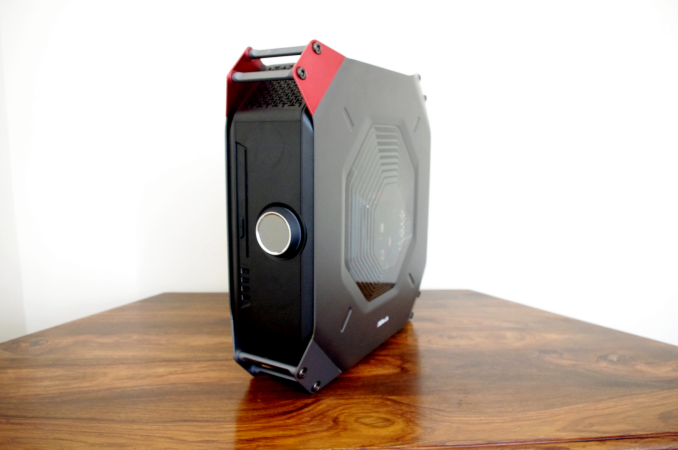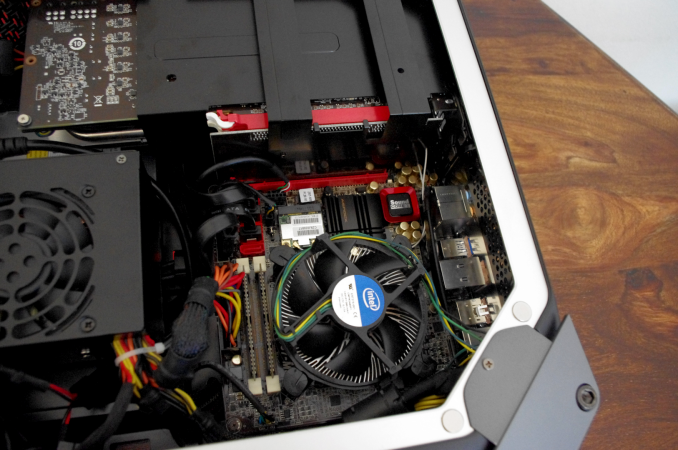ASRock M8 Barebones Review: My Steam Box
by Ian Cutress on January 2, 2014 10:00 AM EST- Posted in
- Barebones
- Intel
- ASRock
- Motherboards
- Cases/Cooling/PSUs
- Z87
ASRock M8 Conclusions: Recommended Steam Box Alternative
Small form factor systems that pack a punch is one of the ways this industry is moving forward. We only have to look at modern consoles and prebuilt systems like the Mac Pro to realize that people want everything smaller with no compromise in performance. Obviously going small means potential heat issues, and then everything centers on keeping the system cool, but also quiet. There is no point in having the world’s smallest computer and making it sound like a jet engine. Of course there are attempts underway to make the PC-you-play-next-to a thing of the past, with streaming from one device to another so heat and noise are no longer part of the equation (this means the realm of big boxes might come back). Nevertheless, there is and always will be a market for the box under the monitor/TV, and the ASRock M8 provides a small form factor system that can be as mobile as you like.
A lot of the buzz around the ASRock M8 will be the industrial design, and the fact that BMW’s design team had their inputs. I want to push that to one side, and take the system as it is – something elegant to look at that is easy to use and that provide sufficient power if a user wants to put the hardware together in order to do so. Using an 8-series platform means that small and large Haswell CPUs can take part, from the 15/25/35W parts all the way up to the full fat i7-4770K, although the 4-phase non-heatsinked solution might be cause for concern if a user wants to overclock. The 450W power supply is plenty for any GPU up to ASRock’s recommended 200W maximum, even though we topped out at ~250W at the wall under a GPU heavy load, meaning that I think that this PSU would handle 300W graphics cards – the only issue then would be heat removal.
In terms of air movement, the system allows a bottom to top air flow, giving the CPU cooling priority over the GPU. This could create issues if the system is placed standing up on a carpet, although the usual place for a console might be next to the TV providing the visuals on a TV stand, or this is the system that at a LAN would end up on the desk next to the gamer. The mobility is going to be one of the main draws of the ASRock M8 – the handles are built into the chassis and are sturdy enough to carry with one hand. Cases like the Bitfenix Prodigy are double the width and have flexible handles – the ASRock M8 solution is a step above this and even more so over handle solutions like the Lian Li TU-200/TU-100. The lock mechanism helps keep the magnetized side panels on, although using a generic lock system might not be the best thing for LAN events whereby some of the people at the event would have a similar locking device.
For hardware specifications, the front panel providing four USB 3.0 ports and a side loading ODD should be plenty, along with the fold out audio and card reader at the bottom. On the inside the motherboard has space for five storage devices whereas the case has room for four – this would allow a nice SSD boot drive and three storage 2.5” drives as necessary allowing the size of the case to not be a hindrance to storage. The motherboard comes with a dual band 2T2R 802.11ac WiFi module and Creative Sound Core3D which match the higher end for the M8 design (some users would point out that Core3D might not be ideal for them), and thankfully due to the nature of the case putting all the hardware in is actually very easy. The only issue I would like to point out is that the ODD color does not match the insides of the case, something which might want to be rectified. On the software side, ASRock bundle their usual BIOS/software combination along with a three month license of XSplit for game streaming. They missed out on an opportunity to do something unique on the M8 in this regard.
The price might remain as the final sticking point. $550 for what could be purchased for $350 (albeit a bit bigger and not as aesthetically pleasing perhaps) might seem a bit of an excessive jump, although I doubt $350 would get something this size and powerful. Take a look at the Tiki which Anand used as part of the GTX Titan release – it came on a granite base and cost a pretty penny. By comparison, the ASRock M8 is a good deal.
The best way to sum up the ASRock M8 is from the gift perspective: buying it will never put your machine on the top of the performance pile, but it does offer something different if you wanted to splash out on a case that remains mobile, or are building a system for a loved one and wanted an out-of-the-box solution that looks awesome.
I started this review mentioning Steam Box and then set about testing a $2000 solution, although removing some of the expensive items it could easily reduce down to sub-$1300 device that would play any Windows and Linux game with comparative ease. I tend to chop and change my PC a lot (I keep bouncing between small and super large every six to twelve months), but for my brother this would be perfect: he games, he goes to LANs, and he needs a bit of power. It would make a nice Christmas present for sure.
After all is said and done, the ASRock M8 is a very nicely built barebones that offers the opportunity to build a mobile gaming platform that should stand the test of time as well as providing nice aesthetics and industrial design. The price might not appeal to most in the bang-for-buck stakes, but ultimately that is not the real point of the M8 – power and size with design. For this, I would like to give the ASRock M8 an AnandTech Silver Award.
ASRock M8: AnandTech Editors’ Choice Silver Award
At AnandTech our rating system goes Platinum, Gold, Silver, and Recommended: Should ASRock release a future version with perhaps another couple of VRMs and a heatsink, it might have been considered for a higher award. I would very much look forward to an X79 platform (or Haswell-E) like this in the future. The main issue there would be heat removal, but I am sure some clever people might be able to figure that one out. Add in some Thunderbolt, Intel NICs, SATA Express – the list could go on to make the system future proof.














78 Comments
View All Comments
wperry - Thursday, January 2, 2014 - link
With cases like this, where size is a major factor, I'd love to see it photographed with a commonplace item so that we have a better sense of scale. Even something as simple as a soda can would suffice.IanCutress - Thursday, January 2, 2014 - link
Here it is next to my Bitfenix Prodigy: https://twitter.com/IanCutress/status/397329549631...Gigaplex - Friday, January 3, 2014 - link
That comparison shot actually makes it look pretty big. I've got a Prodigy and it's not a small case. This M8 looks taller.IanCutress - Friday, January 3, 2014 - link
M8 is a few mm taller, and the bulk goes all the way up. The M8 is almost square, but again, half the width due to the PCIe riser. Compared to all my regular PC cases, the Prodigy is small and mobile - the M8 even more so, for something with a big GPU.Johnmcl7 - Saturday, January 4, 2014 - link
Agreed, I was disappointed not to see it beside the likes of an Xbox 360 and AW X51.pierrot - Thursday, January 2, 2014 - link
I like the riser card design for a flatter size but jeez its uglyXpl1c1t - Thursday, January 2, 2014 - link
With the industry's clear trend towards mitx and potential future adoption of picoitx, it puzzles me why there aren't reference GPU cards with any sort of gaming potential that are built on the half-height PCI standard. Palit's GTS 450 and AMD's 7750 were release years apart and yet remain in the same performance category.Utilizing cards meant for full atx chassis and with lengths exceeding that of a mitx board effectively limits the capabilities of system builders to increase the performance/square-inch factor without resorting to expensive designs requiring special mounting and riser cards... (pointing finger at the recent Mac Pro design, while cool, is a brick in the face of the enthusiast system builder who cannot and will not have the ability to upgrade using market components).
Now, if laptops can run a GTX 880M with sufficient power and cooling... that same chip should as sure as hell me able to be integrated onto a half height card without exceeding the width of a mitx board. Please, add a few more layers on the pcb to accomplish it, we'll still end up saving money via not needing to utilize these sorts of compromising cases.
DanNeely - Friday, January 3, 2014 - link
Probably because sales for those two cards were too poor to justify creating newer cards on the same form factor.bobbozzo - Thursday, January 2, 2014 - link
Hi, what does the KNOB do?thanks!
IanCutress - Thursday, January 2, 2014 - link
Top of page 2:The circular device in the centre is akin to the i-Drive button seen on certain BMW cars – this is the button to turn the PC on. It also shows the date and time, and when in the OS (with the appropriate drivers installed) can be used to adjust the OS volume, implement different power modes, or turn the machine off.